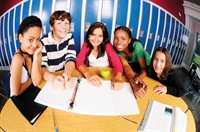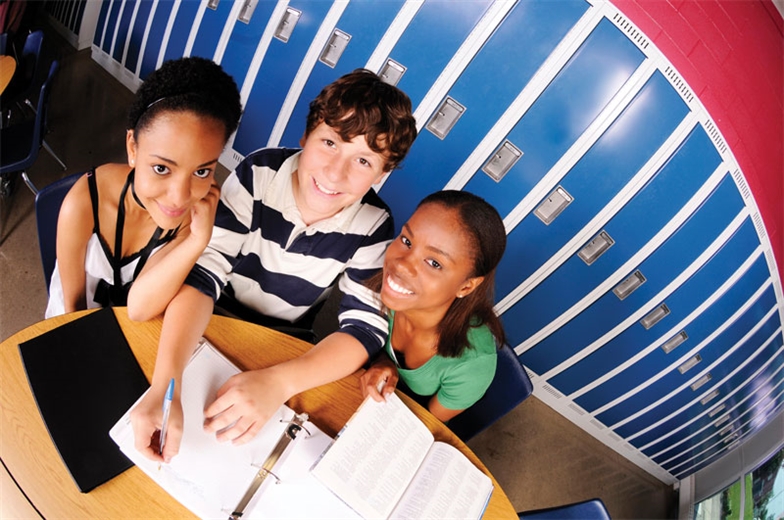Once seen as the domain of school counselors, college readiness is now a shared responsibility among all educators, as well as family members, youth workers, and students themselves. It’s not surprising then, that more and more middle grades teachers and administrators are supporting students’ postsecondary success well before high school.
Middle grades educators not only help students build the academic skills necessary for success in college, they also help students develop goals, organization skills, and good work habits. How can they do more to help young adolescents prepare for college success without having to devote more time or effort? How can they more intentionally support the development of college-readiness skills, especially for students who need the most guidance in their educational journeys?
Educators already recognize what positive forces peers can be in the learning process, as evidenced by their use of cooperative learning in the classroom, peer tutoring programs, and peer mediation and counseling. Peers play a central role in students’ lives, especially during middle school.
Peer Influence
Young adolescents strive to emulate their friends in matters social and academic. Here are some of the ways peers can influence each other with regard to college:
Building hopes and dreams. Young people like to scheme and dream together. Their goals and plans are influenced by social norms and by what they see as cool—or simply
as “normal.” Perhaps it’s not surprising, then, that students are as much as four times more likely
to enroll in college when their friends do.
Forming a college-going identity. Young adolescents are always exploring their identities, often emulating their peers whom they consider to be leaders. It’s important for young people to identify themselves as future college-goers and future college graduates, and to feel comfortable with that identity.
Sharing college knowledge.

Applying to, enrolling in, and financing higher education takes a lot of know-how. Students need to learn early about their postsecondary options, college admission requirements, deadlines, financial aid processes, and more.
Students who are surrounded by friends and family who have gone to college tend to come by this information more routinely than those who are first-generation college-bound, but all students can share this kind of information as they obtain it from multiple sources such as friends, siblings, teachers, counselors, and college access programs.
Lending an academic hand. Working in pairs or groups, students can encourage each other’s good study habits, help with homework, and quiz each other. Through modeling and encouragement, peers can also help each other get organized, plan, and stay on track. The result is often more learning and better grades, which lay the foundation for college acceptance and ultimately college success.
Providing social support. Young people also need social support when the going gets tough and they’re tempted to step off the path to college. Middle school peers are often the go-to source for this kind of support as they accompany each other on college visits, assist with decision making, give encouragement, and serve as sounding boards. Peers can also help each other develop confidence and clear self-concepts relative to school and postsecondary goals.
How Educators Can Help
Of course middle grades educators play an important role in college preparation. Young people often seek out teachers and counselors for information about college. In fact, studies find that low-income, first-generation college-bound youth, who tend to need the most support in preparing for college, rely heavily on educators’ knowledge and are strongly influenced by educators’ aspirations for them.
Teachers and counselors can increase their impact when they work in collaboration with other significant people in students’ lives, including their friends and classmates. The strategies here are designed particularly for middle school. It’s important to note, though, that peer-focused strategies used in elementary school can also help students head down the college path by establishing social bonds and social skills that will benefit
them later.
Use peer learning as a core pedagogical strategy. Learning from peers sets up many of the positive peer processes described above. Making peer learning part of regular teaching strategies can begin with team-building and community-building activities and lead to strategies such as cooperative learning, pair and share, reflective discussions, and group work. Teachers can also encourage students to work together outside class to explore and pursue their postsecondary options through college visits or by talking to adults in the school or community about their college-going experiences.
Use advisory periods to facilitate peer activities. Advisories are a great opportunity to use peer discussion and other peer processes, because they offer a lot of flexibility and room for creativity. Educators can facilitate peer discussions and activities focused on setting goals, anticipating and working through obstacles, discussing personalized education plans, and considering postsecondary options and decisions. Advisory sessions also provide a good context for students to reflect on and talk about their identities.
Integrate postsecondary themes into group projects. Group projects that are linked to postsecondary themes can build college readiness. For example, in groups, students can explore careers related to content they are learning in biology class, research the history of a local university for history class, or discuss the future aspirations and plans of a character in an English class reading assignment. When students engage in these activities collaboratively, they not only make real-life connections, they are prompted to think about and discuss their own futures.
Ask students to interview each other about their postsecondary goals or career interests. The interview format is beneficial in many ways. Not only do interviewees share information that may benefit the interviewers, hearing someone else’s plans can help initiate or reinforce postsecondary goals. These activities also provide a chance for students to practice their interviewing skills, which may come in handy during the admissions process.
Create peer feedback opportunities. Receiving constructive feedback from peers can help students build their confidence and self-concept and increase their comfort in learning from their classmates. Opportunities for peer feedback include having students score each other’s work and giving feedback on assignments.
Encourage peer support outside class. Educators can reinforce postsecondary goals and college readiness outside class by encouraging students to take advantage of peer counseling programs, peer tutoring, and college access programs. More simply, it can mean encouraging students to talk with one another and participate in college planning activities such as college information sessions and campus visits together.
Building Opportunity
When educators encourage peer interaction and support, they do more than simply engage students; they help students develop a sense of identity, leadership, and responsibility. But to maximize their effectiveness in promoting college readiness, educators must harness the power of their own peers. Educators can learn more and accomplish more when they collaborate. When they work together, the result can be more opportunity for students now and in the future.
Suzanne M. Bouffard is a researcher and writer at the Harvard Graduate School of Education. suzanne_bouffard@harvard.edu
Mandy Savitz-Romer a faculty member and director of the Prevention Science and Practice program at Harvard Graduate School of Education. mandy_savitz-romer@gse.harvard.edu
They are the authors of Ready, Willing, and Able: A Developmental Approach to College Access and Success.
Previously published in AMLE Magazine, August 2013.
